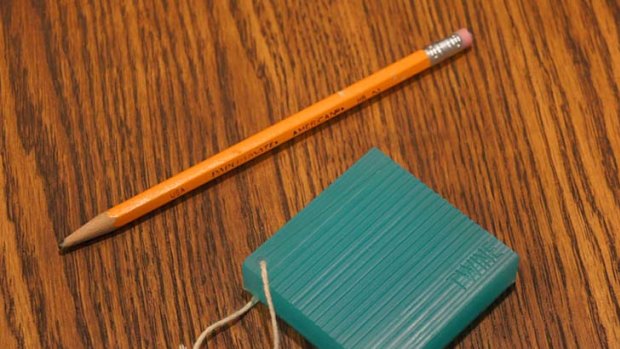This was published 12 years ago
Twine: the revolutionary box that can make your appliances tweet
This post was originally published on ![]()
The day when your washer emails to say your clothes are clean and your basement tweets when it’s flooding is closer than we thought, and it doesn’t look at all as expected. Instead of multiple connected appliances, such a system relies on a tiny wi-fi connected box called Twine.

Twine.
Twine’s functionality is “programmed” through a website that allows users to compose action rules in plain English. One might, for example, compose the rule, “WHEN moisture sensor gets wet THEN tweet, ‘The basement is flooding!’” Programming the device is about as difficult as playing Mad Libs.
Options are endless. The battery-powered box contains sensors for temperature and vibration, a magnetic switch and a moisture sensor. Pretty much anything else can also be added to the contraption. One backer plans to outfit Twine with weight sensors and use it to notify him when the ice machines he operates need refills. Another will use a magnetic door sensor to receive a message when the postman stops by. Others say they will keep track of their pets, heating systems and garage doors using the device.
Twine’s creatrors, MIT Media Lab grads David Carr and John Kestner, consider the device to be the “first time that a connected object has managed to cross in to the world of consumer relevance”.
If enthusiasm for their Kickstarter project is any indication, they’re right. The project has raised more than $300,000. Units are scheduled to start shipping in March with a price tag of $US99.
Q&A With David Carr, co-creator of Twine
Where did the idea for Twine come from?
We started with designing for a need that we ourselves have, to be able to easily try out new interactions in the physical world. When we realised that the same repetitive parts that have nothing to do with the core interaction take up 80 per cent of the effort, an opportunity to optimise presented itself. And we also realised that we were not the only ones who wanted to bring a little bit of the future into our lives.
What are some things that you’ve done using Twine?
I think the most interesting applications are the ones that our users have come up with so far. We’ve gotten dozens of emails from excited users, and our Kickstarter backers have even gone so far as to create a Google doc of their applications.
One example that I liked was from a gentleman who operates ice machines around the city. He plans to put weight sensors under the machines and then have Twine text him where there are only ten bags of ice left in the machine. That way he doesn’t have to drive around all of the time to keep track of which machines need to be refilled.
What is the problem that you overcame that has stopped others from making this before you?
From day one, Twine was designed with the user experience in mind. We wanted to create a product that appealed not just to technology enthusiasts, but to enthusiasts in general. Lots of people are excited about golf, improving their homes, streamlining their business, or just taking better care of their fish. In order to make Twine exciting and accessible for these users, we started over at the beginning. We built a constantly connected cloud based architecture, a novel sensing and processing paradigm, and put a lot of hard work into the hardware to make it live up to our expectations.
How long did it take to reach your $US35,000 goal on Kickstarter?
Kickstarter has been really amazing to us. I think we hit our original goal on the third day.
Are you surprised how much beyond that you’ve raised [more than $US300,000]? What do you attribute this to?
We are floored by how successful Twine has been on Kickstarter. I think that with Twine we hit upon a previously unaddressed need for broadly accessible bits of technology that end users can use to solve problems that they themselves care about. The last two decades have shown that connecting virtually anything to a network (of people or things) greatly magnifies its relevance. We see Twine as the first time that essentially anyone can do that for themselves.
How will this change the world?
We see Twine as the first time that a connected object has managed to cross into the world of consumer relevance. For many years people have been predicting the arrival of “the Internet of things”, but thus far not much has happened in spaces that most people care about. I think our early success with Twine shows that we’ve hit upon a way to cross that chasm, and I’m sure that now many others will try to follow. In the future, perhaps unconnected objects will seem as strange as unconnected [mobile phones] do today.
Mashable is the largest independent news source covering digital culture, social media and technology.